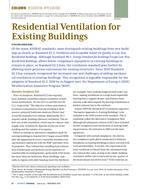The potential of natural ventilation to maintain acceptable air quality and thermal comfort in gymnasia was investigated via a case study of a multisport facility at a university campus in the northeastern United States during the summer months June, July, and August. The ventilation and thermal influence of opening configurations and positions was evaluated by modeling a range of parametric cases. Ventilation opening alternatives included increasing effective ventilation area, enlarging opening size of existing wall vents in different locations and adding rooftop vents. Metrics for ventilation performance were 1) hours during which at least the minimum ventilation flow rate required by ASHRAE Standard 62.1-2013 was maintained and 2) hours during which indoor temperature was kept within the acceptable range as defined by the adaptive thermal comfort model in ASHRAE Standard 55-2013. Relative to the base model, which is a slightly adapted version of the existing building, larger effective ventilation area openings with more even distribution performed better than the existing configuration. Enlarging the opening size was more effective than increasing the effective ventilation area ratio by changing opening constructions. Rooftop vents improved performance particularly in low wind conditions. After implementing the best-performing algernatives: larger opening size, more effective opening construction and better distributed opening positions, acceptable ventilation hours that exceed the minmum ventilation flow rate requirement of max occupancy increased from 21.5% to 93.2% of occupied hours. Thermally comfortable conditions could be maintained during 76.0% of occupied hours, 12% longer than in the base case.
Citation: ASHRAE and AIVC IAQ 2016 Conf
Product Details
- Published:
- 2016
- Number of Pages:
- 8
- Units of Measure:
- Dual
- File Size:
- 1 file , 1.8 MB
- Product Code(s):
- D-2016IAQ-27


